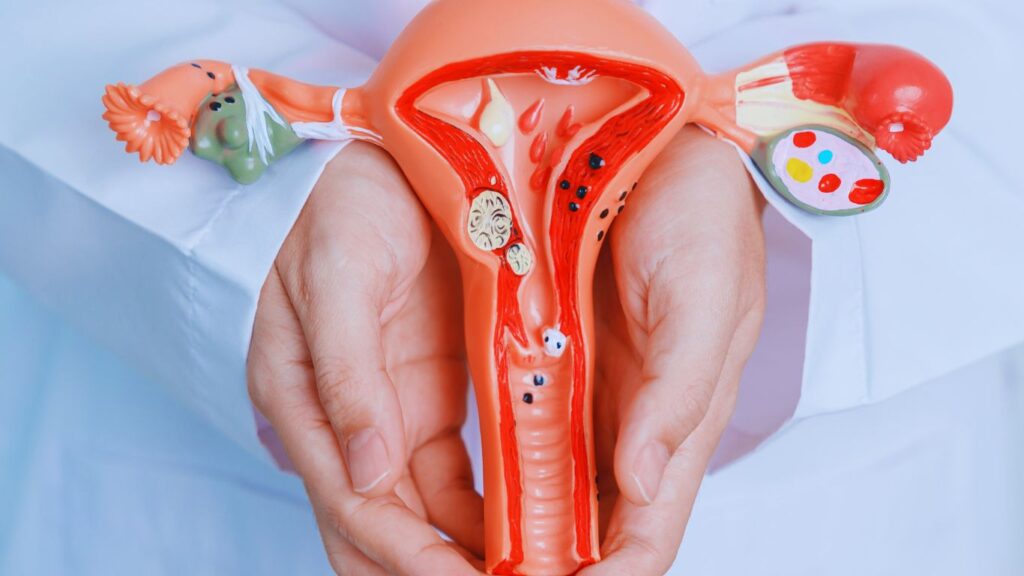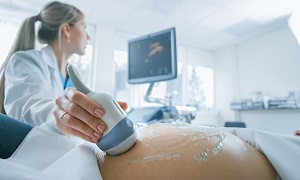What is Adenomyosis?
Adenomyosis is a gynecological condition where endometrial tissue, which normally lines the uterus, grows into the muscular wall of the uterus (myometrium). This disorder often leads to symptoms such as heavy menstrual bleeding, severe menstrual cramps, and pelvic pain. Adenomyosis is a significant cause of abnormal uterine bleeding and is often associated with other conditions like endometriosis and uterine fibroids.
Adenomyosis occurs when endometrial glands and stroma (connective tissue) invade the myometrium, the thick muscular layer of the uterus. This abnormal tissue growth can lead to several changes in the uterus:
- Uterine Enlargement: The affected areas of the myometrium become enlarged and thickened, leading to an overall increase in uterine size.
- Inflammation and Fibrosis: Chronic inflammation due to the presence of endometrial tissue in the myometrium can lead to fibrosis (thickening and scarring of tissue).
- Menstrual Dysfunction: The presence of endometrial tissue within the myometrium results in abnormal bleeding patterns, as this tissue responds to hormonal changes similarly to the endometrium, causing heavy and painful periods.
Types of Adenomyosis
Adenomyosis can be classified into two primary types based on its extent and location:
Diffuse Adenomyosis:The most common form, where endometrial tissue is spread throughout the myometrium, leading to a uniformly enlarged uterus.It is more challenging to visualize and often requires imaging techniques for diagnosis.
Focal Adenomyosis: Also known as adenomyoma, where endometrial tissue forms localized nodules or masses within the myometrium.Can resemble uterine fibroids on imaging studies and may present as well-defined masses.
Symptoms of Adenomyosis
The symptoms of adenomyosis can vary in severity and may include:
- Heavy Menstrual Bleeding (Menorrhagia): Excessive bleeding during menstruation, often requiring frequent pad changes.
- Severe Menstrual Cramps (Dysmenorrhea): Intense pelvic pain and cramping that may not improve with standard pain relief measures.
- Pelvic Pain: Chronic pelvic discomfort that may be present throughout the menstrual cycle.
- Painful Intercourse (Dyspareunia): Pain during or after sexual intercourse.
- Enlarged Uterus: Abdominal bloating or noticeable enlargement of the abdomen.
- Fatigue: Often due to the excessive blood loss and anemia associated with heavy menstrual bleeding.
Risk factors of Adenomyosis
Several factors may increase the risk of developing adenomyosis:
- Age: Most commonly affects women in their 30s and 40s, often those who have had multiple pregnancies or are nearing menopause.
- Childbirth: Women who have had one or more pregnancies are at higher risk.
- Hormonal Factors: High levels of estrogen and other hormonal imbalances may contribute to the development of adenomyosis.
- Previous Uterine Surgery: Previous surgeries, such as cesarean sections or myomectomies, may increase the risk of adenomyosis.
- Family History: A family history of adenomyosis or other uterine conditions may predispose individuals to develop the condition.
Diagnosis
Diagnosing adenomyosis involves a combination of clinical evaluation, imaging studies, and sometimes histological examination:
Physical exam
Imaging Studies
- Ultrasound: Transabdominal or transvaginal ultrasound can reveal an enlarged uterus and identify areas of thickened myometrium, but may not always distinguish adenomyosis from other uterine conditions.
- Magnetic Resonance Imaging (MRI): Provides a detailed image of the uterus and is more effective in diagnosing adenomyosis by showing characteristic features such as the myometrial lesions and the relationship of the endometrial tissue with the myometrium.
- Sonohysterography: An ultrasound with the infusion of a saline solution into the uterine cavity, which may help in assessing the presence of adenomyosis.
Histological Examination

Endometrial Biopsy or Hysterectomy: Definitive diagnosis is often made by examining tissue samples obtained through endometrial biopsy or after a hysterectomy, where adenomyosis can be confirmed by identifying endometrial tissue within the myometrium.
Treatments of Adenomyosis
The treatment of adenomyosis aims to relieve symptoms and manage the condition. Options include:
Medications
- Pain Relievers: Nonsteroidal anti-inflammatory drugs (NSAIDs) such as ibuprofen or naproxen can help manage pain and reduce menstrual cramping.
- Hormonal Therapies: Hormonal treatments, including birth control pills, hormone-releasing intrauterine devices (IUDs), and hormone therapy (such as progestins or GnRH agonists), can help regulate menstrual bleeding and alleviate symptoms by suppressing endometrial tissue growth.
- Antifibrinolytics: Medications like tranexamic acid can reduce heavy menstrual bleeding.
Surgical Treatments

- Endometrial Ablation: A procedure that destroys the endometrial lining to reduce or eliminate menstrual bleeding, although it may not be effective for all women with adenomyosis.
- Hysterectomy: Surgical removal of the uterus is the definitive treatment for adenomyosis and is considered for women who do not respond to other treatments and have completed childbearing
Lifestyle and Alternative The*rapies

- Diet and Exercise: Maintaining a healthy diet and regular exercise can help manage symptoms and overall well-being.
Complications of Adenomyosis
Complications associated with adenomyosis may include:
- Anemia: Due to heavy menstrual bleeding, leading to fatigue and weakness.
- Infertility: Although adenomyosis does not directly cause infertility, it may be associated with other conditions that impact fertility.
- Emotional and Psychological Impact: Chronic pain and heavy bleeding can affect quality of life and emotional well-being.



